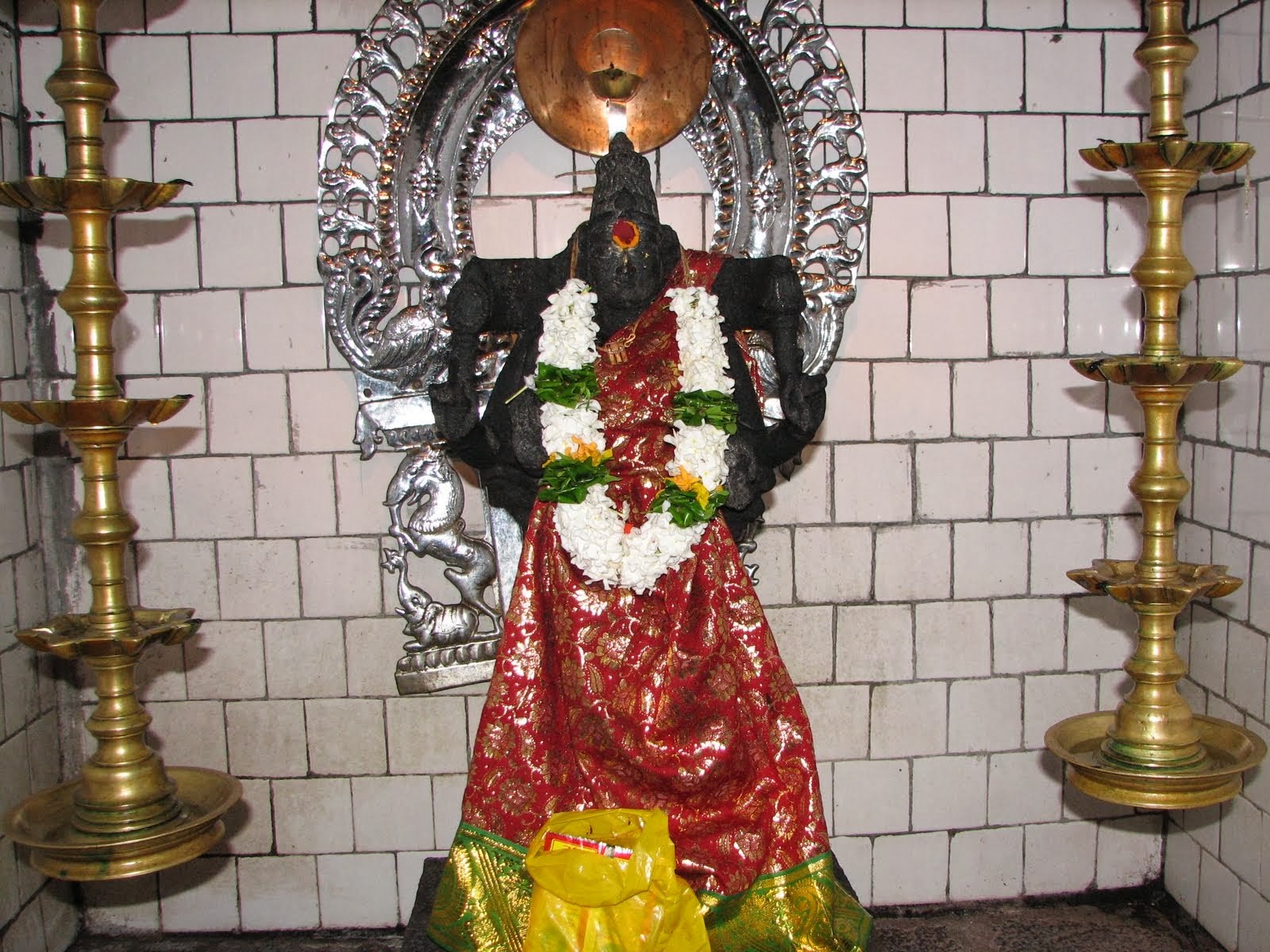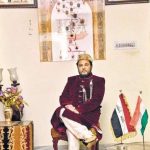Aadi Shankaracharya’s Stotram on Astadasa Peethams begins with Shankari Devi “Lankayam Shankari Devi…”and it is believed this is the place where Sati’s groin had fallen. Sati Devi is worshipped as Shankari Devi and Lord Shiva as Trikoneshwara in Trincomalee, on the eastern coast of Sri Lanka. The local name Thirukonamalai means “Holy Eastern Hill”.
The Temple of Sri Shankari Devi according to the priests, Portuguese who invaded the island in the 17th century have completely cannon balled from their ship and demolished the cliff top Devi temple. Today lone pillar stands in that place as a mute spectator.
The present Shiva temple which is quite well known locally than the Shankari Temple was a recent construction. The Shiva is called as TRIKONESHVARA (Probably because it is in Trincomalee). There is a small Devi Shrine built adjacent the Shiva temple. The famed Bilva tree which is perched right on the edge of the hill some hundred meters above the Indian Ocean. It is a exhilarating and spectacular sight to behold, a paradise. There is also a more famous Kali temple in the heart of the town to which devotees can make a visit en-route from the Shankari Temple.
History
Trincomalee is a natural deep-water harbor that attracted great sea farers like Marco Polo, Ptolemy and sea traders from China and East Asia from the ancient times. The local name Thirukonamalai means “Holy East Hill”. Kona is a derivative of the 1st Century Tamil word Kuna meaning East. Trinco as it is commonly called has been a sea port since the days of the ancient Kings and one of the British Empire’s most important ports in Asia during the second world war. From 1941-45, Trinco had been the headquarters of Lord Louis Mountbatten Allied Southeast Asia commander.

The Koneswaram temple is believed to have been a major religious shrine since before the arrival of Prince Vijaya 2500 years ago. Many inscriptions found in the surrounding area speak of Indian Pallava, Chola and even Pandya kings making contributions to the upkeep of the temple indicating an origin in antiquity. Local legend has it that it was renovated by a Tamil Chola king from South India named Kulakottan. This temple is one of the four important Saivite temple connected to the revival of Hinduism in Sri Lanka. The other three temples are situated in Ketheeswaram, Munneswaram and Galle.
There is evidence that indicates at least some of the later Sinhalese Buddhist kings too maintained the temple although Buddhist King Mahasena was reported to have destroyed it and built a Buddhist temple and Dagoba in its place.
This shrine was demolished in 1622 by the Portuguese (who called it the Temple of a Thousand Columns), who fortified the heights with the materials derived from its destruction. Some of the artefacts from the demolished temple were kept in the Lisbon Museum. The stone inscription by Kulakottan has a dual fish emblem and is engraved with a prophesy stating that after 1500s, westerners with different eye colors will rule the country for the ensuing 500 years and at the end of it, the rule will revert back to Vadugus. Trincomalee was next held by the Dutch and subsequently by them and the French alternately, till the capture of Sri Lanka by the British in 1795.
The hill face is rugged and is called ‘Ravanan Veddu’. As Trinco is full of seismic and volcanic activity as seen in Kanniya Hot Springs area, this rugged face of rock is a reminder of the movement of Earth’s crust in this area. Along with Ketheeswaram in Mannar, this temple was mentioned by one of the Bhakti era Tevaram literature by one of the Nayanmars, namely Sundarar in South India, indicating its popularity even in India.

Thirukonasala Vaipavam, written by the poet V. Akilesapillai is an important literary work in Tamil on the history of this temple. After 1505 A.D, the temple was destroyed by Portuguese catholic colonialists (along with countless Buddhist, Hindu and Muslim places of worship around the island), while the main statue was taken out to town for a festive occasion. At this time Portuguese soldiers entered into the temple dressed as Iyer priests and robbed the temple. The temple was destroyed and its building materials were used in the construction of a nearby fort by the Portuguese. The present statues were found when digging a well in Trinco. During the time of Portuguese rule the statues were hidden in a silted well and were later forgotten. During independence, the ancient statues were finally discovered.
Reconstruction
After a gap of almost 450 years, after the Sri Lankan independence, some Sri Lankan Tamil hindu people of Trincomalee came together and built the present temple in 1952. In size it’s very small compared to the original temple.
Sthala Puranam – Legend of the Place
According to one Puranic reference, Parvati Devi requested Lord Shiva to build a palace for her. But Shiva, used to living in Mount Kailash did not heed to her request. After several requests from Parvati, Lord Shiva finally relented and asked Vishwakarma to build a palace. Vishwakarma built a beautiful palace in Lanka Dweep for Parvati Devi. Lord Shiva and Parvati came to Lanka to perform the Griha Pravesh of their palace. Ravana was doing a rigorous penance to get the blessings of Lord Shiva.
Lord Shiva and Parvati Devi were pleased with the penance of Ravana and Lord Shiva blessed Ravana with boons. Ravana, a Brahmin by birth and master of all the four Vedas was a great devotee of Lord Shiva. Pleased by his penance, Parvati Devi asked Ravana to perform the rituals associated with the Griha Pravesh of their palace. Parvati Devi was impressed with Ravana who did the Griha Pravesh rituals and wanted to bless him with a boon. She asked Ravana to ask for a boon, and he asked for the Lanka palace. Parvati Devi, though saddened initially by the wish of Ravana granted the boon and gave away the palace as Dakshina.
However, Ravana requested Parvati Devi to stay at the palace. Parvati Devi agreed to stay at the palace as Shankari Devi with the condition that she would stay at the palace, as long as Ravana pays heed to her words. After some time, when Ravana brought Sita Devi from Ayodhya, Parvati asked Ravana to return her to Lord Rama. When Ravana refused to return Sita Devi, Shankari Devi left the Lanka Palace for Kailash.
Myths & Legends
There are many Puranic references to Shankari Devi and Tircoamee. It is even believed that Lord Rama visited Trikoneshwara temple to get rid of the Brahma hatya Dosham after the Ravana hata.
Yet another reference is when Vayu, the Wind God and Adishesha, the serpent on which Lord Vishnu rests, had a bitter fight about their individual strengths. Vayu sneered at Adishesha’s strength as he could be easily caught by Garuda, the bird. Adishesha then coiled himself around Mount Kailash and challenged Vayu to attack Mount Kailash. Vayu turned into a hurricane and attacked Mount Kailash.
All the gods and goddesses prayed to Lord Shiva to save them. Lord Shiva asked Brahma to create another Kailash in the South and came to reside at Lanka, also known as Dakshina Kashi. Adishesha lifted his three hoods out of 1000 hoods to listen to Lord Shiva, during which time, Vayu blew over three peaks of Mount Kailash. These three pieces fell in Thondai Naadu (Thiru kalahasti), Chozha Naadu, (Thiruchirupalli) and in Eezha Naadu, Trinkomalee, also Thirukonnamalai in Sri Lanka. The third hill is known as Thirukkonamalai and it lies along the same longitude as Kailash.
Another Puranic reference is that the asura, Kethu swallowed nectar during the Samudra Manthan or churning of the ocean in a fight between the asuras and devas. He attained immortality as he swallowed the nectar. Lord Vishnu who came to know about this beheaded Kethu and he was wandering headless, till such time Lord Brahma took pity on him and made Kethu a Lunar Node along with “Rahu”. Kethu came to Ketheeswaram, prayed to Lord Shiva and obtained Moksha. Thus the place is known as Tiru Kethu esswaram.
Places to visit around the Temple
Bilva Tree
The temple offers a spectacular vista of the calm Indian ocean stretching out for miles. By the edge of the cliff, stands an ancient Bilva tree, under which Sri Rama is said to have meditated.
The Kannyayi Hot Springs
Among the sights of the place are the seven hot springs of Kanniyayi, on the road to Trincomalee. About a mile on a side road branching from the main route, the springs are worth a visit. A high wall assembles all the seven springs in a rectangular enclosure. Each enclosed in a dwarf wall forms a well of its own. The water is mildly hot; the temperature varies but slightly in each. In effect, a public bathing resort, the use of the springs is controlled by the neighboring Mari Amman Kovil who holds the lease of the wells. People believe that bathing in these well will refesh themselves.
Mavaliganga Theertha
The temple theertha, the Mavaliganga, bubbles up from a well at the western portion of the hill, circumambulates the hill and empties into the Indian Ocean. It is believed that when Parvathi once examined Shiva’s matted locks, she caught sight of a woman’s face for a fleeting second. The terrified Ganga froze into and ice drop which was covertly scooped up and dropped into the sea by Shiva. It is believed that it is she who wells up in the Sivanolipadam hills on northern Lanka, flowing towards Thirukkonamalai as Mahabaliganga, towards Ketheeswaram (the only other Paadal Petra Thalam in Lanka) as Manikka Ganga and towards Kathirgama as Kaveri Ganga.









